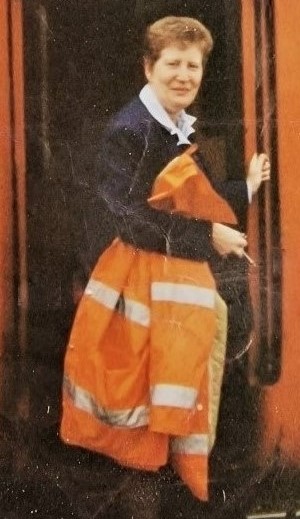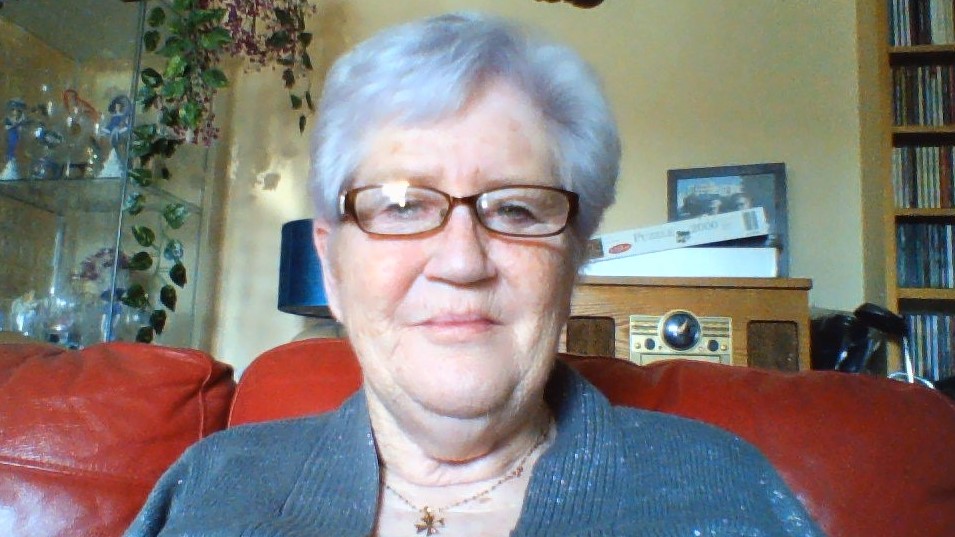Find out more about The Open University's History and Social Sciences courses
Janet started working in the railway in 1986 as a Ticket Examiner on board train, starting on a six-month temporary contract which lasted almost 29 years. Based at Dalmuir, her role as a Ticket Examiner lasted for four years, before she moved on to working as a Guard. This was a role which carried more responsibility, as she had to ensure the safety of the passengers and operate the doors.
 In 1992, she passed out as a driver and was
the only female driver at Yoker Depot at the time. Janet was a driver for 8
years before moving to Glasgow Central to work as a Conductor for 14 years.
In 1992, she passed out as a driver and was
the only female driver at Yoker Depot at the time. Janet was a driver for 8
years before moving to Glasgow Central to work as a Conductor for 14 years.
Janet drove class 303 trains, which were built nearby at Linwood, and nicknamed the ‘Blue Trains’ because of their original distinctive colouring (Scot-rail.co.uk, n.d.).
She said the male drivers were really good to her, and many became good friends. The public could be more challenging: some were shocked to see a female driver and openly commented on her assumed lack of ability. One gentleman said, ‘Oh, I’m not getting on that train – it’s a woman driver!’, to which Janet replied that there was a bus station just five minutes away. However, he boarded the train and ended up complimenting her on such a pleasant journey.
While these kinds of incidents were rare, and she didn’t come up against a lot of prejudice, she remembers a few times where she had to stand up for herself. This became more difficult when Driver Only Operation (DOO) came in, as she was more isolated working alone.
However, she did enjoy the early shifts, seeing the countryside and wildlife on the way up to Airdrie, with foxes, deer and moving the odd creature off the line.
Joining the union
Janet had been in the railway about three months when she joined the National Union of Rail, Maritime and Transport Workers (RMT). In August 1986, she started going to branch meetings, and was the only female who attended. The Branch Secretary would message her that he had put her name down for various conferences and courses, and that’s how she got more involved. She became Chair of the Scottish Trades Union Congress (STUC) Women’s Committee in 2005 and was the first woman from the RMT to be Chair of the STUC, playing a key role at meetings and the annual STUC Women’s Conference.
Representing women
Janet started attending the RMT National Women’s Conference back in 1991. She was asked to go to a meeting and gained a place on the RMT National Women’s Advisory Committee. The RMT’s Women’s Charter sets out clear objectives for the support of women and is ‘…a tool to be used by all members to acknowledge that women still do suffer discrimination’ (Cash, 2018, cited in RMT, 2018). The Women’s Charter sets out the RMT policy on such issues as closing the gender pay gap, flexible working, access to adequate sanitary and toilet facilities, menopause support, and appropriate uniform and personal protective equipment (RMT, 2018).
 Janet Cassidy speaking at the STUC Congress, Aviemore, April 2017As well as being the Branch Secretary
of the North Clyde and the Scottish Women’s Officer, for years she was the only
female from our union going to conferences, so she didn’t have other women she
knew to talk with. At the STUC, and Trades Union Congress (TUC), she was the
only female delegate, and even now women are in the minority. There is only one female place on the
delegation, something that needs to change if women are to continue
to play an equal role in the union. Janet has tried to encourage other women to
take part in union activities and as well as encouraging myself and others to
attend conferences, go on union courses and be more active.
Janet Cassidy speaking at the STUC Congress, Aviemore, April 2017As well as being the Branch Secretary
of the North Clyde and the Scottish Women’s Officer, for years she was the only
female from our union going to conferences, so she didn’t have other women she
knew to talk with. At the STUC, and Trades Union Congress (TUC), she was the
only female delegate, and even now women are in the minority. There is only one female place on the
delegation, something that needs to change if women are to continue
to play an equal role in the union. Janet has tried to encourage other women to
take part in union activities and as well as encouraging myself and others to
attend conferences, go on union courses and be more active.
As a single parent, it was hard when her children were small and she had to rely on her parents for childcare support during her shifts. There were no flexible working or family friendly policies then, and she has fought for years through the STUC and the TUC to develop provision for shift workers. This is still something she campaigns on, both through the branch and with the Clydebank Trades Council, as it remains a challenge for many female workers. Now retired, she still goes to conferences under the banner of the Trades Council where she campaigns on local issues, the latest being at Cairnryan for P & O. She also attends STUC and May Day rallies and has chaired a few hustings for local elections.
Retirement and friendship
 Janet’s work with the trade union movement has
been very rewarding and she has made many friends with people from different
places and unions. She keeps in touch with several through social media and has
enjoyed holidays with some.
Janet’s work with the trade union movement has
been very rewarding and she has made many friends with people from different
places and unions. She keeps in touch with several through social media and has
enjoyed holidays with some.
Janet retired from the railway on 15 June 2015, just one week short of 29 years’ service, due to ill health after a bad fall. She has kept on her union membership and worked at the Union’s Glasgow office, dealing with queries from members, contacting Head Office officials and the legal team when needed. She has learned about other companies as well as ScotRail and how they work, their terms and conditions from maritime, taxi and bus drivers.
Having started her career under British Rail, privatisation in 1994 was the worst thing that could have happened for Janet, as fares rose and the companies tried to break up the unions, allowing overseas companies and countries to bid for franchises resulting in profits going abroad. Although ScotRail has just gone back under public ownership, the fight still goes on to save jobs and cut fares.
For Janet, making a difference and helping others is what motivates her. She continues to campaign on maternity rights, menopause policies and disability rights among many other important issues affecting women’s lives at work. She has inspired so many women, myself included, to get involved and fight for those who aren’t able to.
.jpg)




Rate and Review
Rate this article
Review this article
Log into OpenLearn to leave reviews and join in the conversation.
Article reviews